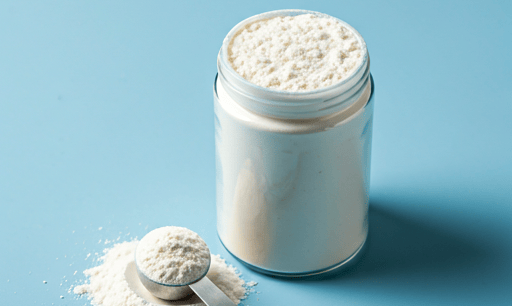Advancement in HMOs: Chr Hansen's Innovation in LNT Production
NUTRACEUTICALSDAIRY & ALTERNATIVES


This is an AI generated illustration and does not represent actual product or service.
Human milk is widely recognized as the gold standard for infant nutrition, providing a unique blend of nutrients, immune-boosting compounds, and bioactive molecules that support healthy growth and development. Among these bioactive components, Human Milk Oligosaccharides (HMOs) play a critical role in shaping the infant’s gut microbiome, enhancing immune function, and promoting cognitive development. However, replicating the complex structure and functionality of HMOs in infant formula has been a significant challenge for the food and nutrition industry.
Chr. Hansen (now Novenesis) has made an advancement in this field with its patent pending method for producing a novel crystalline form of Lacto-N-Triose II (LNT-II), a key HMO. This innovation not only simplifies the production process but also opens new possibilities for improving the nutritional and functional properties of infant formula and other nutritional products.
The Importance of Human Milk Oligosaccharides (HMOs)
HMOs are a family of complex sugars found exclusively in human milk. Over 150 distinct HMOs have been identified, each with unique structural and functional properties. These oligosaccharides are not digested by infants but instead serve as prebiotics, promoting the growth of beneficial gut bacteria such as Bifidobacteria and Lactobacilli. Additionally, HMOs play a role in protecting against pathogens, modulating the immune system, and supporting brain development.
One such HMO, Lacto-N-Triose II (LNT-II), has been shown to:
- Enhance the growth of Bifidobacterium longum subsp. infantis, a probiotic strain crucial for infant gut health.
- Strengthen intestinal immunity and improve the adhesion of beneficial bacteria to the gut lining.
- Support the crosstalk between gut bacteria and epithelial cells, promoting a healthy gut environment.
Despite its benefits, the industrial production of LNT-II has been hindered by challenges in purification and crystallization, often requiring toxic solvents like methanol. Chr. Hansen’s innovation addresses these challenges by introducing a novel, solvent-free crystallization method that yields a new crystalline form of LNT-II, referred to as Polymorph C.
The Innovation: A Novel Crystalline Form of LNT-II
Chr. Hansen’s patent application (WO2025012361A1) describes a method for producing crystalline LNT-II Polymorph C without the use of organic solvents, making the process safer, more cost-effective, and environmentally friendly. The key steps of the method include:
1. Dissolving LNT-II in Water: An aqueous solution of LNT-II is prepared, either from a crude fermentation broth or by dissolving solid LNT-II in purified water.
2. Concentrating the Solution: The solution is concentrated to at least 40% solids, preferably 65%, to form a slurry.
3. Crystallization: The slurry is cooled to 2–15°C and maintained at this temperature for several days to allow crystal formation.
4. Drying: The resulting crystals are dried at ambient pressure and low temperatures (below 50°C) to preserve their structure.
The resulting Polymorph C exhibits a unique crystal structure, as confirmed by X-ray powder diffraction (XRPD) analysis. Unlike previous forms of LNT-II, which required methanol for crystallization, Polymorph C is produced entirely in an aqueous environment, eliminating the risk of solvent residues and making it safer for use in infant nutrition.
Key Advantages of Polymorph C
1. Solvent-Free Production: The absence of methanol or other organic solvents reduces production costs, minimizes environmental impact, and ensures a safer final product.
2. High Purity: The crystalline form achieves a purity of over 94%, making it suitable for use in sensitive applications such as infant formula.
3. Improved Functionality: Polymorph C exhibits unique physical properties, such as enhanced solubility and stability, which can improve its performance in nutritional formulations.
4. Versatility: The method can be integrated into existing fermentation and purification processes, enabling scalable production of LNT-II.
Applications in Infant Nutrition and Beyond
The novel crystalline LNT-II Polymorph C has significant potential in the development of infant formula and other nutritional products. By mimicking the natural concentration of LNT-II in human milk (2–3 mg/L in colostrum and 0.05 mg/L in mature milk), manufacturers can create formulas that more closely replicate the benefits of breastfeeding.
In addition to infant formula, LNT-II Polymorph C can be used in:
- Food Supplements: As a prebiotic to support gut health in children and adults.
- Functional Foods: To enhance digestive health and immune function.
- Pharmaceuticals: As an active ingredient in formulations targeting gut health and immunity.
This innovative method for producing crystalline LNT-II Polymorph C represents a significant leap forward in the field of infant nutrition and functional foods. By eliminating the need for toxic solvents and simplifying the production process, this innovation enables the scalable and cost-effective production of a key HMO, bringing us closer to replicating the benefits of human milk in infant formula.
As consumer demand for clean-label, natural, and functional ingredients continues to grow, innovations like this will play a crucial role in shaping the future of the food and nutrition industry. For manufacturers looking to enhance the nutritional profile of their products, Chr. Hansen’s crystalline LNT-II offers a safe, effective, and versatile solution.
